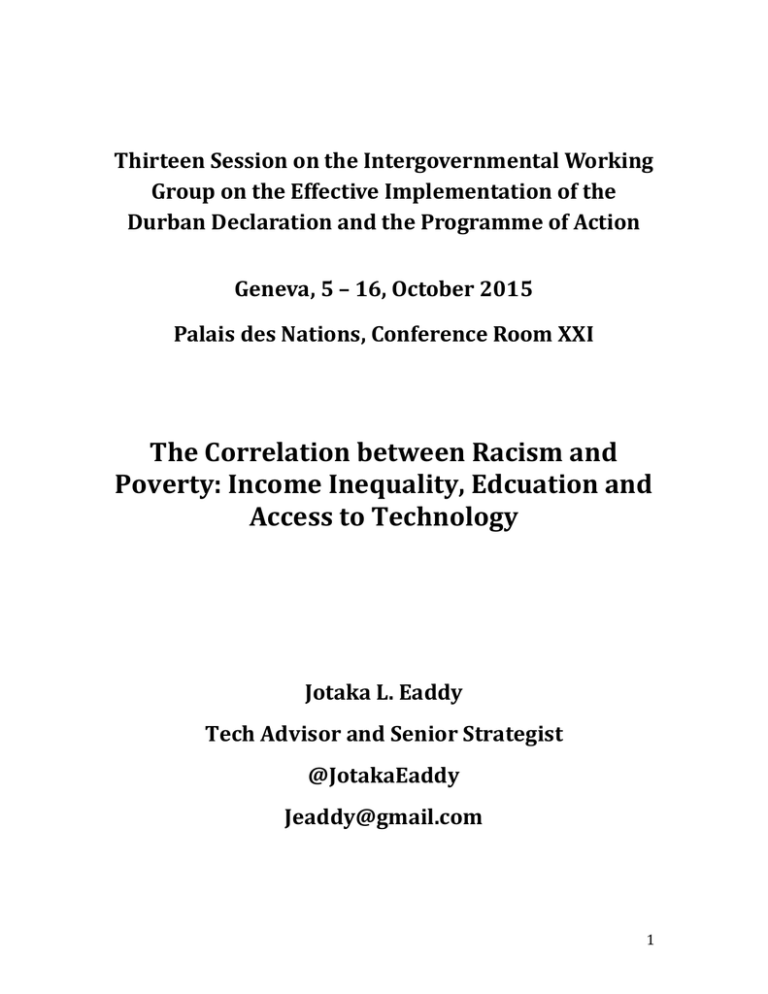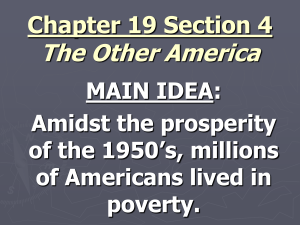Thirteen Session on the Intergovernmental Working
advertisement

Thirteen Session on the Intergovernmental Working Group on the Effective Implementation of the Durban Declaration and the Programme of Action Geneva, 5 – 16, October 2015 Palais des Nations, Conference Room XXI The Correlation between Racism and Poverty: Income Inequality, Edcuation and Access to Technology Jotaka L. Eaddy Tech Advisor and Senior Strategist @JotakaEaddy Jeaddy@gmail.com 1 Introduction: Thank you for the opportunity to address this prestigious body. If I can take a moment of personal privilege, I must note that my first experience with the United Nations was more than 15 years ago when I served as a youth representative to the UN World Conference Against Racism in Durban. As an organizer of the Youth Forum, it was important to my fellow organizers and I, that the Durban Programme of Action recognize the intersection of racism and poverty and set forth recommendations to eradicate both racism and poverty. Today that desire still remains true. I welcome the opportunity to address to this important issue. As the Special Rapporteur on contemporary forms of racism, racial discrimination, xenophobia and related intolerance outlined in his 2013 report to the UN General Assembly, “poverty is closely associated with racism and contributes to the persistence of racist attitudes and practices which in turn generate more poverty.” “Racial or ethnic minorities are disproportionately affected by poverty; and the lack of education, adequate housing and health care transmits poverty from generation to generation, poverty does not result only from an unequal sharing of resources.” He went on to stress that 'Discrimination against groups and persons based on their ethnicity, race, religion or other characteristics or factors has been known to encourage exclusion and impoverish certain groups of the population who suffer from unequal access to basic needs and services.'1 Racism is often described as a system of advantages and disadvantages based upon race. The unfortunate history of racial discrimination and the lingering vestiges of its affect have put in place barriers to resources such as education and adequate housing which have the ability to lift people out of poverty. Simply put – in order to truly deal with the prevalence of poverty, we 1 A/68/333 2 must be willing to tear apart its deep and correlated connection to race. The Correlation of Racism and Poverty in the United States Today I will focus on the intersection of race and poverty in the United States to illustrate the larger correlation of race and poverty. I will focus on three areas: income inequality, education and access to technology in the growing tech sector. Income Inequality In the United States, the median wealth of white households is 20 times that of African American households and 18 times that of Hispanic households. These lopsided wealth ratios are the largest since the government began publishing such data a quarter century ago and roughly twice the size of the ratios that had prevailed between these three groups for the two decades prior to the Great Recession that ended in 2009 African Americans have also been the most unemployed racial group in the U.S. over the last half-century, with an unemployment rate almost consistently double the national average. African American poverty fell quickly between 1959 and 1969, from 55.1 percent to 32.2 percent. But after that, the drop was slower and more uneven. 2 In 2011, 27.6 percent of African American households were in poverty — nearly triple the poverty rate for whites. At a per-capita income of $18,054 in 2008, African-American earnings were just 57.9% that of whites' $28,502. In 2013, African American women and Latinas in the United States are paid $18,817 and $23,298 less than non-Hispanic white men yearly, Paul Taylor et al., Twenty to One: Wealth Gaps Rise to Record Highs Between Whites, Blacks and Hispanics (Washington, DC: Pew Research Center Social and Demographic Trends, 2011). 2 3 respectively. That’s 64 cents and 55 cents for every dollar a man earns.3 The homeownership gaps between whites and people of color have gotten worse or remained stagnant, in spite of reports describing the increase in minority homeownership. These increases have been outpaced or matched by increases in white homeownership. For example, the homeownership gap between whites and AfricanAmericans has gotten worse. The gap in 1940 was 22.8 percentage points, in 1960 was 26.2 points, in 1995 was 28, and in 2010 was 28.5 percentage points. 4 The homeownership gap between whites and Hispanics has improved by only two percentage points from 28.9 in 1995 to 26.9 in 2010.5 Homeownership has long been the primary asset for most Americans. Steadily building modest wealth can leverage education, entrepreneurship, or retirement opportunities. When nurtured over a lifecycle, home equity can be shared with the next generation and further their financial security. Communities of color do not own homes at rates comparable to their White peers, which contributes heavily to the racial wealth gap Civil rights institutions have fought for decades for policies that ensure that qualified borrowers of color are able to access the same homeownership opportunities enjoyed by the rest of the market. Unfortunately, policies to this end have been undermined by lax oversight of financial institutions, faulty implementation, and predatory lending. An abundance of research has shown that African American and Hispanic borrowers were disproportionately sold subprime loans, even when their income and credit profiles warranted standard prime 6 loans. Equal access to mainstream financial services and affordable Ibid. Leigh, Wilhemina and Huff, Danielle, “African Americans and Homeownership: Separate and Unequal, 1940 to 2006.” Joint Center for Political and Economic Studies, Brief #1, November 2007 p.4; and “State of the Nation’s Housing 2011,” Joint Center for Housing Studies of Harvard University, p. 36. 5 Ibid-Joint Center for Housing Studies of Harvard University. 3 4 Robert B. Avery, Kenneth P. Brevoort, and Glen Canner, “The 2007 HMDA Data,” Federal Reserve Bulletin 94 (December 23, 2008); and Debbie Gruenstein 6 4 rental and owner-occupied housing is a critical step toward providing all families with access to wealth-building opportunities, good jobs, schools, transportation, health care, and other factors that determine positive life outcomes. Providing this access has been, and must remain, an important public policy goal. Education American students continue to attend schools that are deeply segregated by both race and class, and schools serving low-income families and racial and ethnic minorities consistently lack the funding, resources, and faculty experience and expertise necessary to improve the education outcomes of students of color. While the federal government has made great attempts to address the academic outcomes associated with vast racial and socioeconomic disparities, there remain deep roots of the underlying causes of those disparities. African Americans are more likely to attend high-poverty schools, public schools where more than 75% of the students are eligible for free or reduced-price lunch and are less likely to graduate from high school and attend college. Two thousand high schools in the United States produce more than half of all dropouts, and a recent study suggests that in the 50 largest cities, only 53% of students graduate on time. Research shows that children of color attend such “dropout factories” at significantly higher rates. Although there is great disparity when it comes to education and race, the dropout rates for whites, African Americans, and Latinos declined between 1980 and 2007. For each year during that period, the dropout rate was lower for whites compared with African Americans and Latinos. Of all the racial groups, African American students are most likely to attend a school that does not offer advanced placement (AP) courses. For example, 19% of African American students attend such schools, compared with only 6% of Asian, 12% of Latino, and 15% of white students. In 2005–06, less than half of all African American male Bocian, Keith S. Ernst, and Wei Li, Unfair Lending: The Effect of Race and Ethnicity on Price of Subprime Mortgages (Durham, NC: Center for Responsible Lending, 2006). 5 students received diplomas with their cohort. The rate at which African American males are dropping out and being placed in special education far exceeds the rate at which they are graduating and reaching high levels of academic achievement. Race and family income is highly correlated with whether a student immediately enrolls in college. The immediate college enrollment rates of high school graduates from low- and middle-income families trailed those of their peers from high-income families by more than 10 percentage points in each year between 1972 and 2007. In 2007, the immediate college enrollment rate was 70% for white high school graduates and 61% for Latino high school graduates, compared with 56% for African American high school graduates.7 A 2014 Pew Research on Social and Demographic Trends found that college graduates ages 25 to 32 who are working full time earn more annually, about $17,500 more, than employed young adults holding only a high school diploma. The pay gap was significantly smaller in previous generations. A college diploma is now more than ever an extremely important pathway out of poverty. This deep racial segregation in education is compounded by socioeconomic segregation. In fact, the correlation is so strong that almost every supermajority-minority school is associated with high levels of poverty, which is not the case for White-dominated schools. Today, “the typical Black student attends a school where almost two out of every three classmates [64%] are low-income, nearly double the level in schools of the typical white student [37%].” This “double segregation” has a deep lifelong academic impact on the students who experience it, as studies show that the concentration of poverty within schools plays a significant role in deter- mining student achievement— even more than the poverty status of individual students. High-minority and high-poverty schools often also have the added burden of lower levels of funding, lower teacher quality, and higher dropout rates. The result is that students whose families already face hardship are placed at an even greater disadvantage further perpetuating the cycle of poverty. 7 NAACP Fact Sheet African Americans and Education 6 To combat the cycle of poverty, widespread investments must be made to expand both the access and quality of education among children of color. Programs aimed at targeted skills building and college preparedness should also be expanded at scale. Access to Technology and STEM Education Blacks and Latino/as are among the fastest growing portions of the population and among the most underrepresented in the rapidly growing tech sector. Data from the Bureau of Labor Statistics show that by 2020, there will be 1.4 million new computer science jobs. Yet, according to the United States Census Bureau, African-Americans and Hispanics have been consistently underrepresented in science, technology, engineering and mathematics (STEM) occupations.8 The average tech worker makes more than the median household income of a Black family and a Latino family combined indicating the great economic opportunity in expanded access to the tech sector. And despite the rapid growth and opportunity in the tech industry, only 1 percent of companies founded by Black are Latinos receive venture funding. Further, although African American and Latinos make up roughly 13.6 and 16 percent of the US Population respectfully, they only account for approximately 5-6 percent of technical employees at top Silicon Valley companies. There is much opportunity in the growing tech sector, yet African Americans and Latinos are locked out. This must change. Equally as important is the need to increase access to broadband and the Internet as expanded access has great potential to provide additional access to educational resources and financial services. According to the Pew Center, 74% of whites and 62% of African http://www.nytimes.com/2015/09/04/technology/silicon-valley-seekingdiversity-focuses-on-blacks.html?_r=0 8 7 Americans and roughly half of Hispanics (56%) have high-speed Internet access at home.9 While access to technology through devices such a mobile devices and smartphones are expanding, there is a need to further expand access to technology and connectivity among impoverished communities. Programs such as President Obama’s recently announced Tech Hire Initiative, which aims to address the deep disparities in the tech industry through public/private partnerships aimed at direct job training and investments in education; have great potential to expand economic opportunity for traditionally underrepresented communities. 10 Additionally programs such as the Level Playing Institute, a program committed to eliminating the barriers faced by underrepresented people of color in science, technology, engineering, and mathematics have expanded the pipeline into tech jobs. The program, which includes a 5-week, 3-year summer residential STEM enrichment program, developmental workshops, mentorship, and support networks has resulted in: 100% of its alumni (student in living at or below the poverty line) graduate from high school; • 75% complete an AP STEM course; • 98% have gone to college or university and nearly half of those to a top-50 school; and • 74% declare a STEM major, compared to 23% of all college freshman11 These programs must be modeled and expanded at scale. Conclusion: The above observations illustrate the deep correlation between race http://www.pewinternet.org/fact-sheets/broadband-technology-fact-sheet/ https://www.whitehouse.gov/the-press-office/2015/03/09/fact-sheetpresident-obama-launches-new-techhire-initiative 11 http://www.lpfi.org/stem-trends/ 9 10 8 and poverty. And further illustrate how the intersection of race and socio –economic status perpetuate the ongoing cycle of poverty. In closing, ultimately at the cornerstone of the pathway out of poverty is increased equitable educational access and economic opportunity. As the global economy continues to increase jobs and opportunity in the tech sector, it will be vital that traditionally marginalized communities have both the skill set and unfettered access to the tech industry. I encourage this body to consider and adopt measures that focus on advancing educational access, expand programs that programs that directly address income inequality, and focus on expanding access to technology and stem education for underrepresented communities. Specifically: Policies that expand equal access to mainstream financial services and affordable rental and owner-occupied housing Policies that incentivize schools and school districts to increase diversity and decrease racial and socioeconomic isolation. Policies that significantly resource educational access and opportunities for underrepresented communities. Policies that significantly expand STEM education and access to Computer Science Education. Policies that expand access to technology and broadband, Specifically programs that expand mobile technology as a means to expand education and financial access. Thank you for your time. 9


